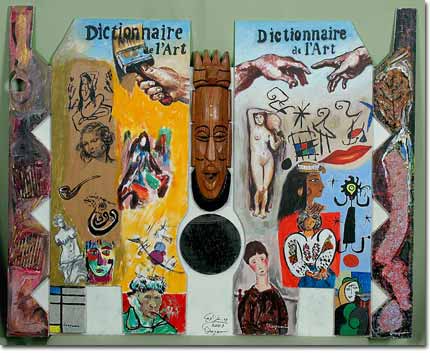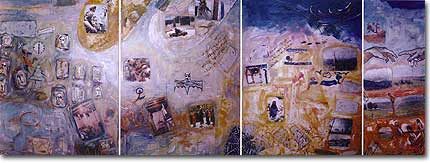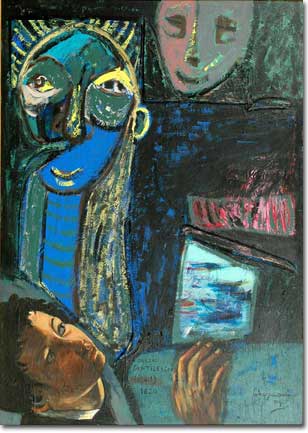A War against Art and Culture, against our progress and development by Samia Halaby
This past month, Lebanese artist Youssef Ghazzawi’s studio was destroyed by Israeli military bombardment for the third time in his life. The first time was in 1977 when his home in the southern Lebanese village of Khiyam was severely bombed. And the second time was in 1983 during the Israeli occupation of Beirut, the apartment building he was living and working in collapsed due to continuous shelling. Under each barrage, his entire studio and most of its content were destroyed. He had salvaged a few things from the previous two demolitions and was saving them. In the most recent destruction of Youssef’s studio his entire life’s output was lost. Able to escape the incessant bombing of his neighborhood by Israeli war planes, he and his family returned to his home and studio, both located in Dahiyeh (the southern suburb of Beirut), only to find disaster. Scattered, buried, or torn to shreds in the bombing, were hundreds of paintings, mosaic panels, work on glass and wood, work on paper, sketchbooks, notebooks, precious mementoes, and a vast library of art books in numerous languages.
Youssef, a professor at the Lebanese University, is an artist of breadth and vast experience. He spent many years in Paris studying and later practicing his art. Much of his work bears the stamp of his international experience. His wife, Suzanne Chakaroune, also an artist and art instructor, shared his studio and also lost all of her work.
During a phone interview on August 16, 2006, Youssef discussed what has transpired over the past month, “I was planning a retrospective exhibition of my work from the past 25 years, and all this work is now gone.”
When asked if he was able to salvage anything this time, Youssef said, “Only some books, the paintings which I pulled out are torn to ribbons, I suppose there might be a chance to restore a couple of them.”
Later in the interview he affirmed, “We are all fed up with war and the attacks by Israel…We know that at any moment they can hit us. I see this war as one against our art and culture, against our progress and development, a war against humanity. We want to create beauty and they find an excuse to demolish us.”
The Lebanese government recently declared that 7 billion dollars’ worth of damage has resulted from recent Israeli bombing. My guess is that if this number is doubled, it would not yet make up for private loss, let alone cultural loss.
Our galleries are shutdown by the Israeli military without warning; art centers and studios are ransacked or destroyed. In 1982, the Museum of Solidarity with Palestine in Beirut was destroyed by Israeli bombardment. Many of us feel this was a deliberate attack. My work and that of other Arab artists, was destroyed alongside that of internationally known artists such as Joan Miro, Eduardo Chillida, and Antoni Tapies.
Yet we are steadfast. The voice of our great culture and its ancient roots entirely negate the justification that Israelis came to Palestine and found a land without people. This is also why our sibling population in Lebanon is subjected to similar destruction.
As a painter, I am horrified to learn of Youssef’s losses. I immediately understand what he conveys, his reaction is my reaction. Under the Israeli occupation of Palestine. Palestinian artists are subjected to terrifying crimes against their artistic production. Our art is often destroyed and confiscated, our palette governed by Israeli laws that prohibit the use of certain colors. In Palestine, artists work knowing that their work could be confiscated or cause their imprisonment and many have been put in prison for merely being artists.
Youssef Ghazzawi and Suzanne Chakaroune both lost the creative output of a lifetime as have many other Lebanese and they know as clearly, as Palestinian artists do, the who and the why of this act of horror again art and culture. Palestine and Lebanon are originally one population and regardless of the long attempts to divide them, beginning with the Sykes-Pekot agreement and now with the deliberate bombing of civilian life by the combined forces of the US, Israel, and with the double standards of the UN. (For those who may not know, The Sykes-Picot agreement of 1916 between England, France, and Russia, set out how the Arab world would be divided by the colonizers. After 1917, Lenin made the high-level secret agreement public.)
As a Palestinian artist I express my admiration, empathy, and respect to Youssef Ghazzawi and Suzanne Chakaroune and to their Lebanese sumoud (Resistance). May you both create the most brilliant masterpieces of your life as time and life allows you in the coming days.
THEY DESTROY OUR ART, OUR BEAUTY,
OUR CULTURE, OUR DEVELOPMENT

I asked Ghazzawi if he has an attitude toward Hezbullah and where he places the blame for all this. He said that he is not a man of and that, “people know that Israel is their enemy.” He said that the blame and responsibility is clear to all the people. “We are all fed up with war and the attacks of Israel. We are all clear that this is a huge attack. We know this clearly. It is not a matter of Hezballah or no Hezballah, It is a matter of progress. We know that at any moment they can hit us. I see this war as one against our art and culture, against our progress and development, a war against humanity. We want to create beauty and they find an excuse to demolish us.”
Ghazzaqi spent many years in Paris studying and later practicing his art. Much of his work bears the stamp of his international experience.
Assistance provided by Farhat Center for Research and Studies of Arab Modern & Contemporary Arts.
His friend’s email is [email protected]
Yousef Ghazzawi cell in Lebanon 961-3-414-830
Comments:
Dear,
I've had a quiet outrage festering over the destruction and body count of the Lebanon / Israeli conflict. Now comes the news that "Painter Loses Everything" in the current clickback. I can't imagine the anguish of having my studio bombed three times as has happened to Youseff Ghazzawi of Beirut, Lebanon and losing a lifetime of work and
resources. My heart goes out to Youseff and all the families who suffer at the hands of war.
Sincerely,
Coulter Watt, Pennsylvania, USA
See his work on page 69 of AlKhiyam book



Arabic Text:
خسر 300 عمل ويفكر بمعرض لما أنقذه وعليه بصمات الدمار
يوسف غزاوي: كيف يدعم بولتون الحرب أمام الغيرنيكا
أحمد بزون
يمكن أن نعيد بناء منزل أو متجر، لكن من يستطيع أن يعيد بناء لوحة أو عملاً تشكيلياً حمل تأريخاً ومزاجاً وصوّر لحظة تعبيرية مكثفة لن تعود للفنان من جديد؟
تلك هي الحرب التي لا تهدم البيوت وتخرب المزارع وحسب، إنما تقضي على مظاهر الإبداع، وعلى منجزات ثقافية وفنية. فقد أطاحت الحرب الأهلية اللبنانية ذات يوم بإنتاج الفنان الشهير سعيد أ. عقل، فحمل هذه الكارثة في داخله وعبئاً على أعصابه وحياته اليومية وسلوكه الذي مال إلى العزلة والإقلال من الإنتاج، حتى انعكست على صحته فكان المرض سبباً في رحيله منذ سنوات قليلة.
اليوم لم يحيّد العنف الإسرائيلي المحترفات الفنية أو بيوت الفنانين، فكانت الخسارة أشد إيلاماً على الفنان الذي وضع نتاجه في مهب عواصف الأمطار الصيفية الحامية.
بين من تضرروا من قصف الضاحية الجنوبية الفنان يوسف غزاوي، الذي كان يسكن في المربع الأمني بحارة حريك، وقد أطبقت سطوح وجدران المبنى الذي يقطنه فوق أعماله وأعمال زوجته الفنانة سوزان شكرون.
التقينا غزاوي وسألناه عن حجم الأضرار التي لحقت بأعماله التي كانت موجودة في منزله/محترفه، أجاب:
خسرت أكثر من 300 عمل فني، كما خسرتْ زوجتي سوزان عشرات اللوحات التي كانت تحضرها لإقامة معرض لها في كانون الأول المقبل. بين أعمالي عدد من التجهيزات الفنية وأعمال التزجيج.
ما خسرته هو نتاج العمر، من أيام الدراسة في بيروت، ثم في باريس، إلى يومنا هذا، أعمال كبيرة وصغيرة وتخطيطات ورقية منوعة.
هل فكّرت في أن تحمل قبل نزوحك عن المنزل بعض الأعمال؟
? استطعت أن أحمل بعض الأعمال القليلة وبعض الكتب والأوراق الخاصة. كنت أتوقع أن يكون الحدث كبيراً، لكنه داهمنا. حاولت أكثر من مرة الوصول إلى المنزل أثناء المعارك لأنقذ ما أمكن، إلا أني لم أفلح.
تأسفت كثيراً على أشياء أخرى غير اللوحات، مثل المذكرات، والمعلومات المخزنة في الكومبيوتر، والكتابات الخاصة، وأرشيفي الخاص.
قرف وألم
علمنا أنك تابعت أعمال رفع أنقاض المبنى الذي تدمر بالكامل لتنتشل ما أمكن إنقاذه. كيف كنت تعيش تلك اللحظات؟
? بالفعل استطعت إنقاذ عشرات الأعمال من خلف <البوكلين> التي كانت ترفع السطوح ومداميك الباطون. لكن بعض تلك الأعمال خرجت مهشمة والبعض الآخر سليماً أو بين بين.
كنت أثناء هذه المهمة أتخبط بين فرح وحزن وتعب وقرف. كنت أعيش مزيجاً غريباً من المشاعر. أحياناً أشعر كأنني أرفع جثثاً.
كنت أشرف على أربع رسائل لطلاب الديبلوم في معهد الفنون، وأجريت المناقشات بعد وقف إطلاق النار، لكن الملاحظات التي وضعتها حول الرسائل بقيت تحت الأنقاض، ومع ذلك شاركت في المناقشة، وها أنا أفكر في إقامة معرض للأعمال التي أنقذتها، على أن أعلقها كما هي، بكل بصمات الدمار والخراب عليها.
حزنت لأن كل أعمال معرضي الأخير الذي أقمته العام الماضي أتلفت، فهي نتاجي الجديد الذي أفتخر به، كذلك كنت أنوي إقامة أول معرض لي في بلدتي الخيام لأحقق حلماً كثيراً ما راودني. بدل هذا المعرض أقامت إسرائيل في الخيام معرضاً كبيراً لأساليب القتل والدمار.
هل تفكر في استعادة بعض أعمالك أو استحضارها من خلال تكرارها؟
? لا أتصور أنني أستطيع ذلك، لأسباب كثيرة، فحالة صناعة اللوحة لا تتكرر، والوضع النفسي الماضي مختلف عنه اليوم، وإذا فعلت ذلك سوف أفشل. قد أستعيدها بتذكرها، وبما تبقى منها من صور فوتوغرافية.
ألا تفكر في استعادة عناوين بعض اللوحات أو مواضيعها؟
? قد أفعل ذلك، فأقدم لوحة جديدة. بعض الأهل عندما يفقدون إبناً فيسمون مولوداً جديداً باسمه.
هل تفكر برسم الحدث، العدوان ككل، والمأساة التي حدثت لك شخصياً؟
? إبان الحدث لا أستطيع إنتاج عمل فني. قدمت بعض التخطيطات والرسوم السريعة كالتي نشرتها في <السفير> أثناء العدوان. أتصور أن المرحلة قاسية وحجم الدمار كبير والأسلحة التي استخدمت لم تكن مسبوقة من قبل. كل ذلك يشكل حافزاً لي لإنتاج أعمال جديدة.
حتى الآن لم يمر بمخيلتي أي موضوع معين، كل ما أشعر به كما قلت هو ذلك القرف والألم الأشد وقعاً وخطورة من آلام الحرب والدمار، القرف والألم الناتجين عما يجري على المستوى السياسي الداخلي في لبنان.
كيف تتطلع إلى ما حدث بعيداً عن خساراتك الخاصة؟
? ما حصل هو فيلم أميركي طويل. نحن ضحية السياسة التي تخطط للمنطقة، ضحية خلافات داخلية وخارجية. ومن الطبيعي أن يكون المثقف أو الفنان أكثر ألماً من سواه، إذ إن مثل هذه المعاناة تلازمه كل حياته.
جريمة حرب
ما الذي يعوض عليك خسارتك؟
? لا شيء غير القلم والريشة والقلب الذي يعاني وينتج. كنت أسمع بفنانين خسروا أعمالهم في الحروب، لكن النار تكوي مكانها بالفعل.
أعلل نفسي أحياناً بأن خسارتي ليست خاصة بي، فما ينتجه الفنان يصبح ملك الجميع. نعرف أن جامع لوحات ياباني أحب لوحة لفان غوغ فأوصى أن تدفن معه عندما يموت، فأجابه سامعوه: إن العمل الفني ملك البشرية. ما آسف له أن أعمالي دفنت ولم يستطع أحد إنقاذها.
أريد أن أعلق على مشهد تكرر كثيراً على الشاشات، هو وقوف السفير الأميركي جون بولتون أمام غيرنيكا بيكاسو ليطلق تصريحاته الحربية ويصب الزيت على نار الحرب، في حين أن بيكاسو وضع لوحته ليصرخ بها ضد الحرب.
مشهد آخر أثارني هو ما تناقلته وسائل الإعلام لصورة مجموعة من الأطفال الإسرائيليين وهم يوقعون على القذائف الصاروخية ويكتبون رسائل الموت هدايا لأطفال لبنان. هذا يذكرني ببيكاسو الذي قال: قضيت خمسين عاماً من عمري لأستطيع أن أرسم مثل الأطفال، لكن إسرائيل تُحوِّل الطفولة إلى أغراض أخرى بعيدة عن البراءة. إنه عمل غير مسبوق في التاريخ، وجريمة حرب مضاعفة يجب أن تُحاسَب عليها إسرائي.